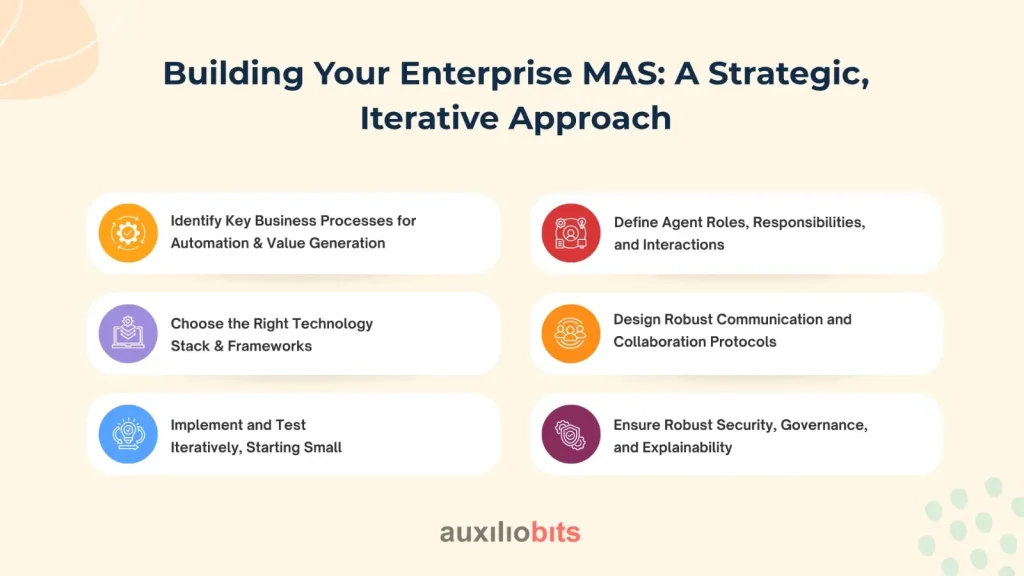
Key Takeaways
- Multi-Agent Systems (MAS) go beyond traditional automation by enabling distributed, intelligent collaboration across enterprise functions.
- MAS improves adaptability and resilience, allowing businesses to handle disruptions and market volatility with minimal downtime.
- MAS seamlessly integrates disparate systems like ERP, CRM, SCM, and legacy platforms, eliminating silos and manual data handoffs.
- From supply chain to finance to HR, MAS delivers real-world benefits such as predictive analytics, resource optimization, and proactive support.
- Adopting MAS requires a strategic, phased approach—starting with high-impact use cases, defining agent roles, and ensuring governance, explainability, and security.
In today’s time, where there is so much competition among businesses, they are under continuous pressure to do more with less. They have been in search of beneficial solutions that help them spend less money, make informed decisions, and improve their business efficiency. Even though automation tools like robotic process automation and artificial intelligence are some solutions, Multi-agent systems are the best one, providing a smart and adaptive solution for automation that can help enterprises revolutionize from end-to-end.
What is a Multi-Agent System (MAS)? Delving Deeper into the Concept
A multi-agent system is like a team of skilled, experienced, and independent digital assistants who collaborate and communicate with each other to achieve a common yet challenging goal.
- Autonomous: Every single agent operates independently. From initiating actions to reacting to changes and making decisions, it does it all without needing any staff member to work side by side.
- Interacting: One needs to understand that agents are independent and not isolated. They can interact with each other whenever needed through knowledge sharing and messages. This collaboration is the main element that helps them take on challenges and tackle them alone.
- Intelligent: Even though intelligence can differ, AI agents can incorporate elements of AI and ML. This allows them to learn from history, understand a new scenario and adjust, and make fast decisions. For example, an agent might use predictive analysis to forecast demand or use NLP to understand a customer challenge and offer a solution.
- Goal-Oriented: Every agent is designed with a specific purpose or set of goals. Whether it’s to process an invoice, respond to a customer, or monitor a server, each agent contributes to the overarching objective of the larger system.
Think of it like a highly coordinated team of specialized human experts: a sales agent, a logistics agent, a finance agent, and an IT support agent. Each handles their specific area of expertise, but they seamlessly communicate and collaborate to ensure the entire customer order, from initial inquiry to final delivery and invoicing, is handled efficiently and accurately.
Why MAS for Enterprise Operations? Addressing Core Business Challenges
Traditional enterprise systems often operate in isolated “silos.” An ERP system might manage inventory, a CRM system handles customer interactions, and a separate accounting system manages finances. While each is powerful individually, connecting them seamlessly and dynamically has always been a significant challenge, leading to:
- Manual Handoffs: Data is often manually transferred between systems, leading to errors, delays, and increased labor costs.
- Lack of Real-time Visibility: Critical information might be fragmented across different systems, making it hard to get a holistic, real-time view of operations.
- Rigid Processes: Traditional systems can be inflexible, making it difficult to adapt to new business rules or market conditions without extensive recoding.
MAS directly addresses these challenges by:
Enhancing Automation & Efficiency Beyond RPA:
While RPA automates repetitive, rule-based tasks, MAS takes it further. It can automate complex, multi-step processes that span different departments and disparate systems. For example, an MAS could fully automate the “Order-to-Cash” cycle, where agents handle order validation, inventory check, shipping coordination, invoicing, and payment reconciliation, all without human intervention unless an exception arises. This frees up human resources for more strategic, creative, and customer-facing initiatives.
Improving Adaptability & Resilience to Market Dynamics:
Businesses operate in increasingly volatile, uncertain, complex, and ambiguous (VUCA) environments. Traditional monolithic systems can be brittle. MAS, with its distributed and autonomous nature, is inherently more adaptable and resilient. If one agent or a specific underlying system encounters an issue (e.g., a shipping carrier’s API is down), other agents can often compensate, reroute tasks, or find alternative solutions, ensuring business continuity with minimal disruption. This “graceful degradation” is a significant advantage.
Optimizing Resource Utilization Across the Board:
Agents can intelligently monitor resources (human, financial, and technological) and optimize their allocation based on real-time data and business priorities. For instance, an agent could dynamically allocate cloud computing resources based on fluctuating demand, or an HR agent could intelligently match available employees to urgent tasks, leading to a more efficient use of all organizational assets and preventing bottlenecks.
Enabling Intelligent, Data-Driven Decision-Making at Speed:
By integrating vast amounts of data from various enterprise systems and leveraging advanced AI/ML capabilities (like predictive analytics, prescriptive analytics, and even reinforcement learning), agents can go beyond just data collection. They can analyze complex patterns, provide actionable insights, recommend optimal courses of action, and, in some cases, even make autonomous decisions within predefined boundaries. This leads to more informed, faster, and more consistent business processes, moving from reactive to proactive operations.
Facilitating Seamless Integration and Breaking Down Silos:
MAS can act as a sophisticated, intelligent integration layer, effectively breaking down the communication barriers between disparate systems like Enterprise Resource Planning (ERP), Customer Relationship Management (CRM), Supply Chain Management (SCM), Manufacturing Execution Systems (MES), and legacy applications. Agents act as intelligent intermediaries, translating data and orchestrating workflows across these platforms, creating a truly unified operational environment.
Key Applications of MAS in Enterprises: Real-World Impact
The transformative potential of MAS is not theoretical; it’s being applied across various enterprise functions, driving tangible benefits:
Supply Chain Management:
- Demand Forecasting: Agents analyze historical data, market trends, and even social media sentiment to provide highly accurate demand predictions.
- Inventory Optimization: Dynamically adjust inventory levels across multiple warehouses, minimize holding costs, and prevent stockouts by coordinating with procurement agents.
- Logistics & Route Optimization: Agents can find the most efficient delivery routes, manage unforeseen delays (e.g., traffic, weather), and even negotiate with carriers in real-time.
- Supplier Relationship Management: Monitor supplier performance, automate order placement, and flag potential supply chain disruptions.
Customer Relationship Management (CRM):
- Personalized Customer Service: Chatbot agents can handle first-line support queries, escalate complex issues to human agents with relevant context, and provide personalized recommendations based on customer history.
- Lead Qualification & Nurturing: Agents can analyze prospect data, qualify leads based on predefined criteria, and automate personalized follow-up sequences.
- Sentiment Analysis: Monitor social media and customer feedback channels to gauge sentiment and trigger proactive interventions.
- Customer Lifecycle Management: Automate reminders for renewals, special offers, and post-purchase support.
Financial Operations:
- Automated Invoice Processing & Reconciliation: Agents can extract data from invoices, match them against purchase orders and receipts, and reconcile accounts, significantly reducing manual effort and errors.
- Fraud Detection & Prevention: Continuously monitor financial transactions for suspicious patterns and flag potential fraudulent activities in real-time.
- Expense Management: Automate expense report submission, approval, and reimbursement processes.
- Financial Forecasting & Budgeting: Agents can analyze financial data from various departments to create more accurate forecasts and assist with budget allocation.
IT Operations & DevOps:
- Proactive System Monitoring: Agents can monitor servers, networks, and applications, detect anomalies, predict potential failures before they occur, and automatically trigger alerts or corrective actions.
- Automated Incident Response: For common issues, agents can diagnose problems and execute predefined solutions (e.g., restarting a service, scaling up resources) without human intervention.
- Cloud Resource Optimization: Dynamically scale cloud resources up or down based on demand, optimizing cost and performance.
- Security Operations: Agents can monitor for security threats, analyze logs for suspicious activities, and automate threat response protocols.
Human Resources (HR):
- Automated Recruitment: Agents can screen resumes, schedule interviews, send automated communications to candidates, and manage the onboarding checklist.
- Employee Support & Q&A: Chatbot agents can answer common HR queries (e.g., benefits, policies), freeing up HR staff.
- Performance Management: Agents can collect and analyze performance data, schedule reviews, and assist with feedback processes.
- Learning & Development: Personalize training recommendations based on employee roles and skill gaps.
Building Your Enterprise MAS: A Strategic, Iterative Approach
Implementing a Multi-Agent System is a strategic initiative that requires careful planning, a clear roadmap, and an iterative approach. It’s not a one-size-fits-all solution but a tailored implementation:

1. Identify Key Business Processes for Automation & Value Generation: Don’t try to automate everything at once. Start by pinpointing specific areas that are characterized by:
- High manual effort or repetitive tasks.
- Frequent errors or inconsistencies.
- Significant bottlenecks that impact overall business flow.
- Processes that are crucial for customer satisfaction or revenue generation.
- Example: Automating the order fulfillment process from initial order capture to shipment tracking could be a high-value starting point.
2. Define Agent Roles, Responsibilities, and Interactions: This is the architectural phase. Clearly outline:
- What each agent will do: Its specific functions and capabilities (e.g., an “Order Validation Agent,” a “Logistics Coordination Agent,” a “Payment Processing Agent”).
- What data does it need: The inputs it requires to perform its tasks.
- How it will interact with other agents: The communication protocols and decision points for handoffs.
- What external systems will it connect to: Databases, APIs of ERP/CRM systems, etc.
3. Choose the Right Technology Stack & Frameworks: The technology choice will depend on the complexity and requirements of your MAS. Consider:
- Agent Development Frameworks: (e.g., JADE for Java, SPADE for Python, or custom frameworks based on microservices).
- Communication Protocols: (e.g., FIPA-ACL for agent communication or standard APIs like REST, Kafka for inter-service communication).
- Underlying AI/ML Technologies: Libraries for natural language processing (NLP), machine learning (Scikit-learn, TensorFlow, PyTorch), decision-making algorithms, etc.
- Orchestration & Workflow Tools: Tools to manage the overall flow and coordination of agents.
4. Design Robust Communication and Collaboration Protocols: The success of an MAS hinges on how effectively agents can communicate and collaborate. This involves:
- Defining common message formats and semantics.
- Establishing clear rules for negotiation, task delegation, and conflict resolution among agents.
- Ensuring fault tolerance in communication channels.
5. Implement and Test Iteratively, Starting Small: Begin with a focused pilot project that addresses a specific, high-impact business problem.
- Develop a minimal viable MAS for this pilot.
- Thoroughly test its functionality, performance, and resilience.
- Gather feedback, identify areas for improvement, and iteratively refine agent behaviors and interactions.
- Only after successful pilot deployment, gradually expand the system to encompass more complex processes or additional business units.
6. Ensure Robust Security, Governance, and Explainability: As MAS becomes central to operations, these aspects are paramount:
- Security: Implement strong authentication, authorization, data encryption, and network security measures to protect the agents and the data they handle.
- Governance: Establish clear policies for agent development, deployment, monitoring, and auditing. Define human oversight mechanisms and intervention points.
- Explainability (XAI): For critical decision-making agents, strive for explainable AI where possible, allowing humans to understand the reasoning behind an agent’s actions, which is crucial for compliance and trust.
The Future is Multi-Agent: A Paradigm Shift for Enterprise Success
As businesses continue to navigate increasing complexity, global competition, and the accelerating pace of technological change, Multi-Agent Systems will undoubtedly play an increasingly pivotal role. They represent a significant paradigm shift from fragmented automation to truly intelligent, collaborative, and adaptable enterprise ecosystems. By strategically embracing this intelligent automation paradigm, enterprises can unlock unprecedented levels of efficiency, enhance their responsiveness to market demands, drive continuous innovation, and ultimately achieve sustainable growth and long-term success in the digital age.








